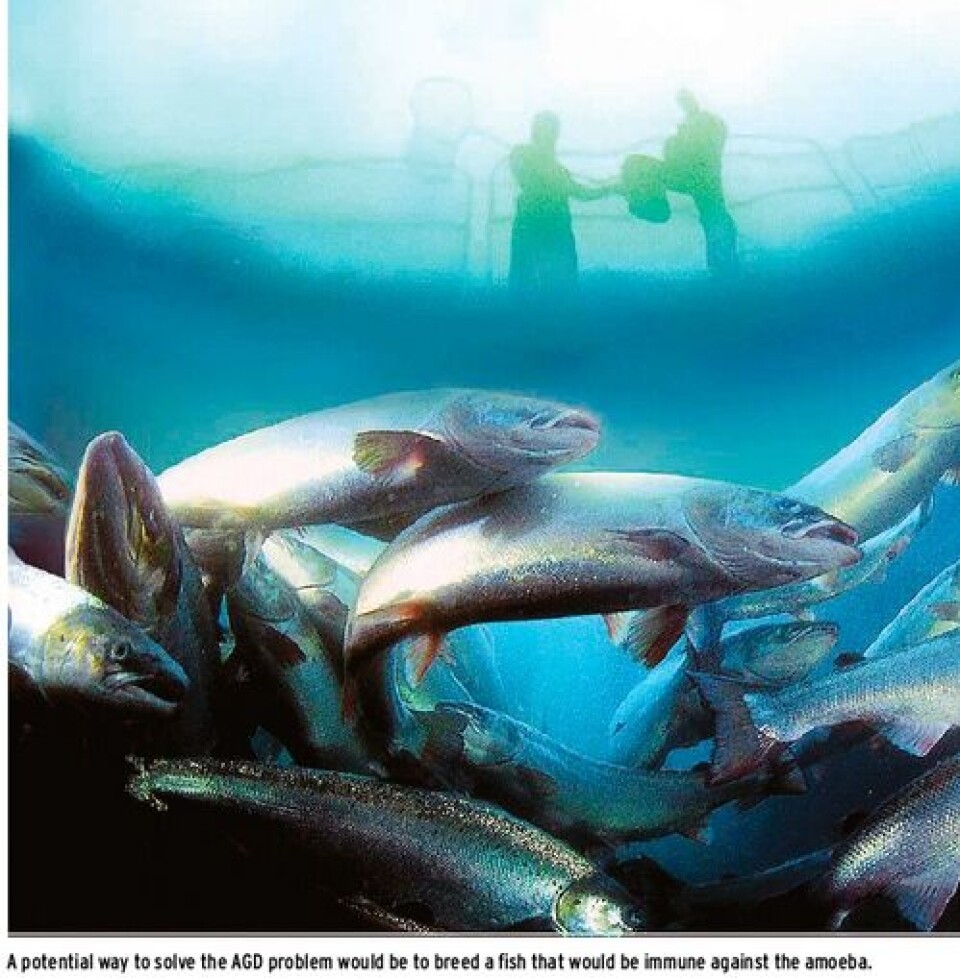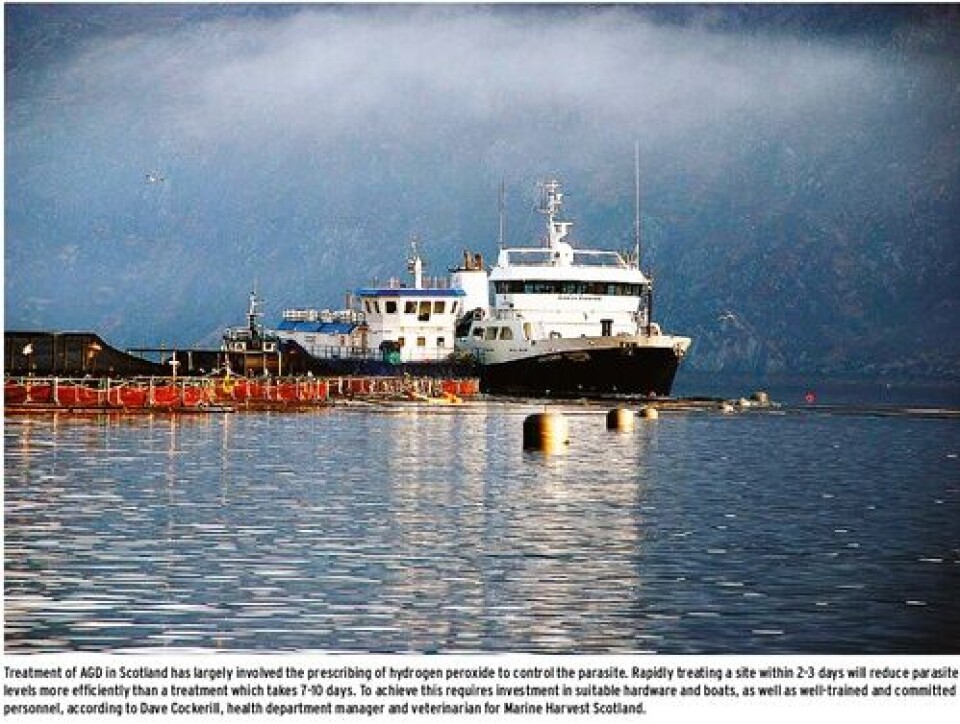Careful management key to restrict AGD
Siri Elise Dybdal siri@fishfarmingxpert.com
Last year, amoebic gill disease (AGD), caused by the amoeba Neoparamoeba perurans, hit the Scottish industry hard causing low growth rates and mortalities which led to economic losses for many salmon producers.

Although the definitive factors causing the proliferation of amoebae are not fully understood, environmental and host factors as well as other potential concurrent pathogens are believed to have an important role in disease predisposition.
It is believed that the severity of the problem in Scotland in 2012 was down to the weather conditions; the summer and winter were dry and warm and salinity levels were high above average. Water temperatures above 10ºC were thought to have triggered the disease. However, Scottish outbreaks have occurred at temperatures from 7.5 to 13.5 ºC. And according to the Scottish government, recent studies show high salinity (>32 ppt) as a more relevant risk factor.
High stocking densities, smolt size, quality and genetic origin, suspended organic matter, bio-fouling and previous gill damage could also affect disease occurrence.
Spreading across boarders Over the years there have been occasional incidents of AGD in Scotland, but never to the extent seen last year. In Ireland however, AGD has appeared on and off for the last 10-15 years. Several other fish producing countries have also been hit to a smaller and greater degree. Most notably AGD has affected the Tasmanian Atlantic salmon industry, where it is estimated to cost A$20 million a year in treatments and lost productivity.
Norway, like Scotland, long remained relatively unaffected by the disease, but this autumn several cases were uncovered and it is reported that the disease has spread with record speed, leaving the Norwegian industry very concerned.
The amoebae is transmitted through water and occasionally recorded on wild salmon without causing significant pathology. However, these fish do not appear to be a reservoir of the pathogen. This apparent difference in incidence may be due to the higher stocking densities in aquaculture and the difficulty of obtaining samples for disease diagnosis in wild fish.
Could reappear The Scottish industry has not seen the same impact from AGD in 2013, as the previous year. Salmon companies have reported an improved biological situation, although they are under no illusion that the battle is won as the right conditions could escalate the occurrence.
According to Sheltand-based Grieg Seafood Hjaltland, the AGD situation this year shows an improvement on the corresponding period last year and the company has a strategy in place to deal with AGD:
“Grieg Seafood Hjaltland has established a much improved strategy and preparedness for the treatment of both lice and AGD, and this is now being reflected in positive results in the form of a better biological status and increased seawater production,” the company claimed in its Q3 2013 report.
In its half year report, Dr. Stewart McLelland, chief executive officer for The Scottish Salmon Company (SSC) also said the biological development of the current stock was good and performing normally. However, he added that costs related to AGD could increase in the second half of the year: “But against this positive backdrop we must expect higher production costs in the second half of 2013 because of historic issues with AGD.”

In its Q3 2013 report, Marin Harvest Scotland said the major biological key performance indicators continued the positive trend in the third quarter. The Scottish entity did not encounter challenges related to AGD in the period. But elevated mortality had been recorded at one site in October.
The company also said there are no other sites facing health challenges in Scotland at present, but the health team and seawater production department are prepared to take immediate action if problems should arise at other sites.
Three focus areas Dave Cockerill, health department manager and veterinarian for Marine Harvest Scotland says the treatment of AGD in Scotland has largely involved the prescribing of hydrogen peroxide to control the parasite. According to him, success requires strong focus in three main areas:
“The first is stock monitoring and constant gill checking, which we’ve found to be critical in building up accurate data on AGD. Recording gill scores and monitoring of trends on a constant basis is vital so that a rapid treatment can be organized in the event of deterioration. In order to have useful data it is critical that health monitors have been properly trained so basically they know what they’re looking at and can differentiate between uncomplicated AGD on the one hand, and mixed gill pathologies on the other. We loosely refer to the latter as PGD or proliferative gill damage/disease, which has many causes including plankton and jellyfish challenge. When AGD is complicated with these additional pathologies, fish can be more sensitive to treatment and dose rate and exposure time needs to be reduced,” he reveals.
Apart from treating clinical outbreaks, the second area of focus is the use of ‘strategic’ treatments even when there is little or no clinical disease, Cockerill says. “We already know that strategic anti-sealice treatments in late winter or early spring are critical to control the levels of this parasite going into the summer, and there is no reason to believe that AGD is any different in this regard. Low levels of the amoeba are likely to be present even at the lowest temperatures of the year and by treating to reduce this threshold to an even lower level, it should take longer for these parasites to re-escalate to a clinical level in the summer,” he claims and adds that a second strategic treatment should also be considered in July or August.
“Sites with a regular occurrence of autumn gill challenge will be difficult to treat for AGD during the months of September and October, because the plankton and jellyfish damage will make them very sensitive to AGD treatments.” The procedure and logistics of carrying out hydrogen peroxide treatments is the third key area Cockerill emphaises: “Rapidly treating a site within 2-3 days will reduce parasite levels more efficiently than a treatment which takes 7-10 days. To achieve this requires investment in suitable hardware and boats, as well as well-trained and committed personnel,” he underlines.
Not the same as sea lice Alan Dykes, fish health services manager for Europharma Scotland has also worked as a fish vet for the industry dealing with AGD. He agrees that monitoring stock, well-trained staff and treatment at an early stage are key factors when managing the amoeba. However, he does not believe strategic treatments against AGD will have results:
“I am a biologist and from my point of view it makes no sense to have a national treatment strategy. Amoebas are very different to sea lice, as they are already in the marine environment,” he says and points out that this means they can reappear quickly. “In Australia, once they start treating against AGD, they can’t stop. The costs for the Tasmanian industry are high,” he adds.
Dykes says there have been similar experiences in Scotland. They would use wet preps on site which would lead to clearance. But then two weeks later, the amoeba would be back and they had to do it all again. He adds that there is no doubt that when there are 1000 salmon hosts to grow on, it doesn’t make the situation easier. The experience in Scotland suggests mortalities are typically 10-20%, but losses as high as 70% have occasionally been reported. In chronic cases low but on-going mortalities can persist for up to three months.
Treatments According to the Scottish government, data does show that some outbreaks disappear without treatment. However, freshwater baths or hydrogen peroxide are more widely accepted treatments. Chemical treatments can be effective if used at early stages of the disease, but they can also be detrimental by increasing tissue damage and decreasing oxygen uptake in fish with already severely compromised gills.
Dykes says formalin is not allowed for use by SEPA and the use of freshwater have been very limited in Scotland over the course of the past year due to logistical issues and perceived regulatory obstacles. They also trialled feed diets, but this made no difference he claims, and adds that this was also the result when it was tested in Tasmania. This leaves the farmers with hydrogen peroxide, which he says is effective in stripping the gills of the amoeba.
Dykes underlines that the practicalities surrounding the administration and timing of the treatments are key factors influencing their use and success. Avoiding stress is recommended in all cases.
“In Tasmania currently, the only effective and commercially used treatment for AGD in farmed salmon is freshwater bathing,” Dykes says. This is the best method as it clears the site and also kills lice without any side effects. Freshwater treatments are however not a feasible option in Scotland due to availability. “We could produce freshwater using membrane technology in freshwater plants and fill well boats with freshwater. The problem is the volumes it would involve and the costs. “But freshwater could be used on some sites in Norway – they could just run a pipe and poor in freshwater.”
In Tasmania, treatments are carried out every month, and there are gill checks every week – two times a week if there are high water temperatures. The extra costs used in relation to AGD are recovered later through a market premium. “In Norway, Scotland and Chile this would not be the case. They can’t afford it,” Dykes claims and adds that it is always possible grow fish, but if the costs rises too it will not make economic sense.
Genetic components He believes global warming is the key factor for the increase in AGD, and the problem is therefore likely to be even more prevalent in the future. “Realistically, the situation in Scotland will be like Ireland - some years we will get it and some years not. But it will eventually get more and more frequent.”
He believes breeding fish with certain genetic components such as robustness could be part of the solution: “A potential way to solve the problem would be to breed a fish that would be immune against the amoeba,” he says.
In one Scottish farm with fish from wild strains, Dykes says he saw an interesting reaction to AGD; some fish had no reaction to the amoeba at all and the scores of AGD were half compared to other sites. Differences in resistance of stocks are currently being investigated.
Some reports also show higher prevalence in Atlantic salmon in their first year at sea and development of resistance after first infection:
“Reports from Tasmania show that once a fish has seen the amoeba, it does not have as hard reaction the second time,” Dykes says. This was also observed in Scotland: “Where the amoeba had been present the previous year and treatment had been carried out, the following year there were amoeba on the fish without it being a really big issue.”
This meant that this year, the Scottish industry has treated less than in 2012: “It is a nerve wrecking decision, in case they start developing AGD. But fortunately it worked,” Dykes says.





















































